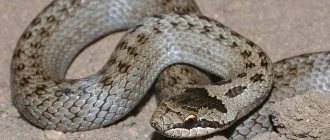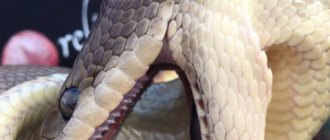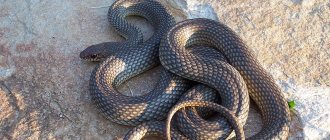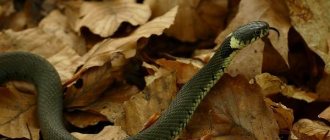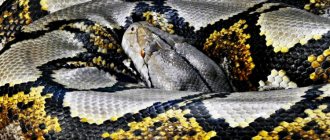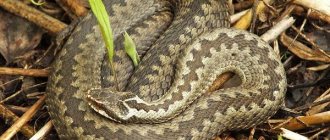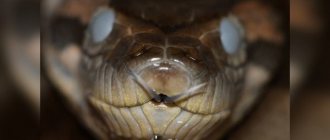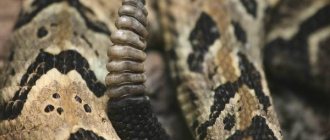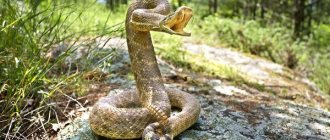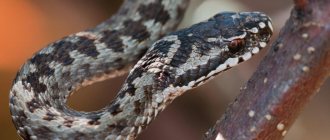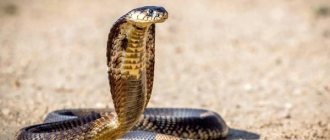The viper is a species of poisonous snake from the Viper family (a genus of giant vipers). This snake is very dangerous for both humans and domestic animals. She is capable of making sharp throws towards the enemy the length of her entire body.
Even experienced snake catchers have often been victims of this terrible, insidious snake, since, trying to free its head, the viper makes strong and very sharp dangerous jerks.
Poisonous snakes: varieties
There are varieties of snakes: poisonous and harmless.
The first (most dangerous) include the well-known viper and cobra, the little-known black mamba, viper, etc. The common viper (almost everyone knows it) lives in almost all territories of Russia. We can find it in any area: in forests, mountains, steppes, fields, swamps and meadows. This is one of the few snakes that can live even in cold climates.
The cobra is a large snake (venomous), which, when in danger, raises its front third of its body, while expanding its neck in the shape of a disk. It is a spectacled snake found mainly in Africa, India and South Asia.
The black mamba is also a type of poisonous snake - incredibly dangerous and deadly, considered one of the most insidious snakes in the world. It got its name because of the dark color of the inside of the mouth (blue-black). This is a fast, aggressive and deadly poisonous snake. It lives in the savannas and rocky hills of Africa (southern and eastern parts). It is the longest African venomous snake (up to 4.5 meters).
24.08.2016
Today we reached the fescue-feather grass steppe. Under one of the stones we were lucky to find a collared ereinis - a small snake that feeds exclusively on insects. We saw a viper in the crevices, but we couldn’t take a photo: it was lying too awkwardly, and I didn’t want to touch it and risk my life.
We made a stop under the rocks: griffon vultures were flying in the sky, and blue rock thrushes were jumping nearby. It’s not very hot in the shade, and while Evgeniy Anatolyevich gave a lecture to schoolchildren about nature researchers, I dozed off for an hour.
We returned at dusk and again found several scorpions. And on the way we saw a very rare bird for Russia - Eleonora's falcon. For the first time in our country, it was noted by a birdwatcher (as volunteers who watch birds are called) from the USA in June of this year in this very place. And already in August we saw it ourselves.
The nature of the Dagestan Nature Reserve is very diverse. There are mountains and plateaus, gorges along which stormy streams rush in the spring, and fescue-feather grass steppes. Near the Sarykum dune, at the foot of the Narat-Tyube ridge, the Shura-Ozen River flows, providing water to all living things all year round. The surface of the earth here can heat up to +60°C. Photo: Ilya Gomyranov/Schrodinger's Cat
Viper - poisonous snake: description
The viper is the largest representative of reptiles of the viper family. Its entire body length (including tail) is almost 2 meters, and its weight is about 5 kg.
She has a very large and wide head, a round muzzle, and her eyes and pupil are vertical. There are ribbed scales on the entire upper surface of the head. It is usually monochromatic in color, but sometimes has a complex pattern in the form of spots and arcs. The shields over her eyes are missing.
The number of scales in the area of the middle of the body is approximately from 23 to 27, on the peritoneum - from 126 to 181, and under the tail - from 33 to 53 pairs.
This venomous snake has a grayish-brown coloration on the top of its body. According to the pattern, there are individuals both monochromatic (black or brown) and with purple shades. There are several dark brown transverse spots on the back, and there are them on the sides, but they are smaller in size. The snake's belly is light, with small dark spots.
21.08.2016
A couple of nights on the train, where already in the first morning it felt like we were going south: the temperature in the carriage exceeded +30°С degrees, outside +35°С. At noon we were in Makhachkala. About another hour by car and we are at the foot of Sarykum. The staff of the Dagestan Nature Reserve greeted us like our closest friends and placed us at the cordon.
In the evening, after unpacking our things, we go for a walk around the area. Fillies and grasshoppers are singing around, the cries of an owl can be heard from the ruins of the abandoned Kumtorkala station, and from the forest the melancholy “spitting...” of a small insectivorous owl. On the first day I was lucky to find a Caucasian scorpion.
The Caucasian scorpion (Mesobuthus caucasicus) is a small insect widely distributed in southern Russia. Its venom is quite strong and can cause swelling in humans at the site of the bite. In Sarykum, this scorpion is a common sight; we regularly found them under stones, and sometimes in corridors and even in shoes, where they climbed at night. Venom from related species is used in Chinese medicine to treat diseases such as epilepsy and paralysis. Photo: Ilya Gomyranov/Schrodinger's Cat
Spreading
These snakes are common in North-West Africa, on the islands of the Mediterranean, in South, Western and Central Asia. Snakes of this type of reptile inhabit the territories of the following countries: Syria, the Arabian Peninsula, Israel and the (western) bank of the Jordan River, Iraq, Iran, Iraq, Afghanistan, Turkey, North-West India and West Pakistan.
They are also found in the former republics of the Union: in Transcaucasia, Azerbaijan, on the Absheron Peninsula and throughout Central Asia.
The south of Kazakhstan is the place where today the viper has been practically exterminated and is quite rare.
The snake in Dagestan lives in several isolated populations. The number in this republic is low and on average for its territories is 1 individual per 13 hectares. In those places where their habitat density is higher, it is 1 individual per 0.8 hectares. Here you can find a snake with dark brown spots on the sides. Its length is about 1 meter.
This local snake is deadly. 20% of the total number of victims bitten by it die.
Interesting Facts
- The snake sheds three times throughout the year. First, she intensively rubs her head on hard surfaces—stones, twigs, dry soil—until the skin cracks. Then it crawls in a narrow space between stones and tree roots. As a result, the skin peels off like a stocking. She hides somewhere for some time, then returns to nature again.
- The molting period often coincides with dry summers. If there is no rain, the snake “soaks” for a long time in the dew or is immersed in water to soften the skin. It is then easier to separate from the body.
- Small snakes are born already poisonous. True, they need to practice for some time to make the correct bite.
- Numerous stories about the unmotivated rage and aggression of the viper are most often either exaggerated, or the objects being studied were very agitated before this. The snake does not attack without serious reasons.
- In the former Soviet Union, Uzbekistan and Turkmenistan, there were special snake nurseries in which viper was raised in order to obtain its poison. They were kept there in huge quantities. These snakes are hardy. They live long in captivity and produce a lot of poison.
- The wonderful Russian writer Lazar Karelin wrote the novel “Snake Catcher” in 1982. The hero, having experienced life turmoil, went to Central Asia specifically to catch viper, because it was a very profitable and honorable business. The character's prototype single-handedly captured over 50 of these venomous snakes.
- In Azerbaijan, one of the most delicious dishes, reminiscent of our dumplings, is called “gyurza” because of the pattern on the dough.
- One of the Russian special forces units bears the code name “Gyurza”. Swiftness, endurance, intelligence, excellent orientation in space, a striking blow - these are the qualities of this snake that were in mind when choosing the name.
- Serdyukov’s self-loading armor-piercing pistol, created for special forces units, also bears this threatening name “Gyurza”. It is likely that the strength and speed of this reptile, which is a deadly weapon in itself, inspires respect and a desire to use its name to intimidate the enemy.
Hunting
The viper is a snake that is an excellent hunter. On the ground or on some stone, it waits for its prey, and when it approaches, the viper makes a sharp, lightning-fast lunge. Having grabbed it, it does not let go of the prey, but waits for the poison to take effect, and then swallows it. Since these snakes have a very good appetite, a short time after eating food they continue their hunt.
Gyurza, like most snakes, loves to swim, while at the same time catching birds arriving at a watering hole.
23.08.2016
We decided to get up at five in the morning to climb the dune and return before it got hot. Walking on sand is not easy: your feet constantly fall through and slide down. But our efforts are rewarded with stunning views from above. The entire sand is lined with animal tracks that can be read like a map: a darkling beetle crawled, and a jerboa jumped.
We find the mink of the long-eared roundhead - the same one that I dreamed of seeing. We dig it up: already 15 centimeters from the surface the sand is wet and cool, and here is the owner of the hole! She opens her mouth with displeasure, showing off her “ears,” but as soon as she realizes that she won’t be able to escape, she begins to vibrate and within a couple of seconds she buries herself back into the sand.
At the very end of the route we came across a fox hole - from there two surprised and frightened eyes looked at us. We moved away from the entrance, and the fox instantly ran away. Nice meeting.
Long-eared roundheads (Phrynocephalus mystaceus) are very large roundheads, reaching 12 cm in length. The main feature of these lizards are their “ears” - folds of skin at the corners of the mouth. The skin here is permeated with blood vessels, and when the roundhead tries to scare a predator, its vessels fill with blood and the “ears” acquire a frightening purple-red color. Long-eared roundheads are typical inhabitants of sand dunes, where they dig shallow, straight burrows in which they hide from the heat. Photo: Ilya Gomyranov/Schrodinger's Cat
Viper's lifestyle, habits
In the spring (March-mid-April), the males are the first to crawl out of the wintering areas, followed by the females a week later. At first, they stay close to their winter shelters (near cliffs or at the foot of cliffs), and then go to their summer habitats. And in the fall they return to their wintering places.
The viper is a snake that hibernates either alone or in groups of its relatives (about 12 snakes each). Their inactive period lasts on average up to 130-150 days (Transcaucasia). The daily activity of snakes depends on the season: in spring and autumn - during the day, in summer - in the morning and evening, and also from dusk to the first half of the night.
With the arrival of a hot period of time, they are located closer to springs or other most humid places. Moreover, each individual owns its own hunting area. They live most densely near springs and rivers.
Reproduction and lifespan
The viper in Central Asia is an oviparous snake, which is rare in the viper family. In other habitats, it is viviparous, like other individuals of the family. In spring, first the males crawl out into the sun, followed by the females, 6-7 days later. Having warmed up, they begin to mate.
Snakes curl into balls, and sometimes it’s not even clear who the “author” of the offspring is. The mating season lasts about one and a half months, until the beginning of June. The female lays eggs after 20-25 days. The maternity clutch consists of 15-20 eggs with already highly developed embryos.
The eggs are not covered with a shell, but with a slightly transparent skin. Sometimes you can see through it the future offspring inside. In the south of Tajikistan, clutches of up to 40 eggs have been observed in captivity.
The incubation period is 3-7 weeks. Newly born small snakes are up to 28 cm long. The hatching process occurs from July to early September. When they are born, they can become prey for anyone, from their own parents to other snakes, even non-venomous ones - yellow snakes, for example. Mature viper has practically no enemies in nature.
Of course, she could be attacked by a large cobra or a gray monitor lizard; they could be waylaid by a wolf, a jungle cat and a jackal. Only their offender can suffer from the bites of the viper. The only real enemy of this snake is the serpent eagle. Gyurza is his favorite delicacy. In living fauna they can live up to 10 years. In the serpentarium, their lifespan is significantly longer - 17 years; there were cases where they lived up to 20 years.
Nutrition
The usual diet includes viper. An adult snake mainly feeds on small mammals (mice, pikas, gerbils), less often catches lizards, and even less often - its fellow snakes.
In spring and autumn, in places where birds fly (wagtails, buntings and their chicks), snakes wait for their prey, climbing on bushes. They can also wait for prey in vineyards. Rarely, newborn snakes can also eat insects.
Due to extensive extermination, the population of this reptile has decreased. And in captivity, most often the viper can live only a few months. Due to such circumstances, the viper is included in the Russian Red Book and is now under state protection.
19.08.2016
The desire to visit this place arose in me exactly ten years ago, when as a schoolboy my mother and I came to the Zoological Museum of Moscow State University to join the circle of young naturalists.
I saw a photograph by Evgeny Dunaev: a long-eared roundhead in the Astrakhan desert. Her open mouth and red “ears” were imprinted in my memory for the rest of my life. I really wanted to see her, to see this sand dune - a childhood dream, supported by stories and pictures. And a few months ago Dunaev, now not only a teacher, but also a best friend, wrote to me: “Will you go to Astrakhan?” Did I even think for a minute, doubt? There was only desert in my head, I was jubilant with delight. Then plans changed, and we went to Dagestan, to the largest Sarykum dune in Russia.
We are standing on the platform of the Kazan station, it is pouring rain. The Moscow-Makhachkala train departs.
The Sarykum dune is the largest in Russia and one of the highest isolated sand massifs in Eurasia; its height is 245–252 meters. Strictly speaking, Sarykum is not a dune: its crest regularly moves according to the will of winds blowing from the west and northwest in winter, and in the opposite direction in summer, so the term “dune” is more appropriate here. The origin of Sarykum remains a mystery; scientists regularly put forward hypotheses regarding the appearance of a “sand mountain” among the rocks and clayey steppe. Photo: Ilya Gomyranov/Schrodinger's Cat
30.08.2016
We are sitting at the station in Makhachkala, waiting for the train, surrounded by the unusual bustle of the city. Then again a couple of days of travel and Moscow. Meeting with family, endless tasks and concerns: every trip leaves many impressions, emotions and shots in the camera.
Ilya Gomyranov is a biologist and wildlife photographer. Winner, laureate and finalist of photo competitions “Golden Turtle”, The Best of Russia, “The Art of Science”. Participant of more than 20 expeditions - visited the tundra and subtropics, the Middle and Far East, Africa and the New World.
25.08.2016
The reserve staff suggested going to the Samur Forest, a unique place in the very south of Russia, on the shores of the Caspian Sea. A section of tropical forest where trees are entwined with vines as thick as a human arm, and maples form plank-shaped roots. We agreed without hesitation. Most of the day was spent on the road, but in the evening we walked through an amazing forest, swam in the sea and sat by the fire.
The Samur Forest is the only area of subtropical liana forest in Russia, located in the very south of the country, on the border with Azerbaijan. Here you can find over 15 types of vines, the thickness of which can be greater than a human hand. Photo: Ilya Gomyranov/Schrodinger's Cat
28.08.2016
In the morning, a viper was found in one of the old, abandoned buildings - another dream came true. Under the supervision of my colleagues, I photograph a dangerous snake. At other moments, there are only a few centimeters left before it, then they pull me back: safety comes first. Just recently, a shepherd died from a snake bite. At the end of the photo session, please take the snake away from the cordon so that it does not bite children.
After lunch we go to the barn to photograph lesser horseshoe bats - these are rare bats, a colony of which has settled very close to the cordon. During the day they sleep in a cool basement, and at night they fly in search of food.
It was a very beautiful sunset. All the previous ones were quite monotonous: the sun simply disappeared behind the horizon.
A small colony of lesser horseshoe bats (Rhinolophus hipposideros) settled in an abandoned barn near the reserve's border. These are very unusual bats, living in colonies of 10–50 individuals. Giant ears and a special leaf-shaped outgrowth near the nose help them with echolocation, which is necessary for hunting in complete darkness. Photo: Ilya Gomyranov/Schrodinger's Cat
26.08.2016
In the morning, a large Mediterranean turtle was found on the camp grounds: it was crossing the clearing with its usual leisurely step. A wildcat and a wild boar with piglets were scared away near the pond.
For lunch, we planned an excursion to an experimental fish hatchery where Russian sturgeon, beluga and trout are raised. Upon reaching a certain size, the fry are released into the sea to replenish the population of rare fish in nature.
On the way back we decided to visit the oldest city in Russia - Derbent. I fell asleep in the car, and when I woke up, I couldn’t figure out what country I was in. The car drives along narrow winding streets that rush upward towards the fortress; the city architecture resembles Iran, and the people speak a different language - that’s the impression Derbent, a piece of the eastern world on Russian territory, made on me.
The Mediterranean turtle (Testudo graeca pallasi) is listed in various Red Books as a species with a sharply declining population. A separate subspecies lives on the territory of the Dagestan Nature Reserve, some of its representatives reach an impressive size of 30 cm, their weight can exceed 3 kg. Photo: Ilya Gomyranov/Schrodinger's Cat
27.08.2016
In the morning we go to the Markov Gorge, on the other bank of the Shura-Ozen River. There are clouds in the sky, which means that there will be no sweltering heat. On the way we observe Caucasian agamas, which masterfully run along the rocks and almost hide in the cracks. Ancient people turned one of the rocks in this gorge into an “art gallery.” Here you can see images of horses, cows, and deer. Unfortunately, modern residents follow the example of their ancestors and cover the rock - no, not with drawings, but with names and dates.
We walk back along the very bottom of the gorge; in spring there is a lot of water here. Cow and sheep skulls are scattered everywhere - apparently, they are carried here from the slopes of the mountains, where local residents still graze their cattle. Among the dry vegetation we observe wingless mantises - Bolivarians. At the exit from the gorge we find another Mediterranean turtle, this time a large male.
In the evening we have a joy - rain: in the summer in the desert this is rare, and it has become cooler.
The Caucasian agama (Laudakia caucasia) is a rather large lizard (36 cm with tail), in Russia it lives only in the territory of Dagestan. A typical inhabitant of the Central Asian foothills and Transcaucasia; runs freely along steep rocks and, in case of danger, hides in crevices, from which it is impossible to remove the lizard, since its skin is very bumpy and covered with spines. Photo: Ilya Gomyranov/Schrodinger's Cat
